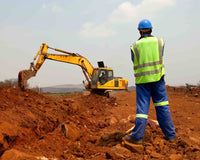First Aid Basics

Some of those reading this have probably heard horror stories about injuries occurring on the job, and of another worker running to the first aid kit to find it missing antiseptic, or bandages, or something else basic and necessary. It happens, and a blunder like that can cost someone a limb or even their life. The Occupational Safety and Health Administration (OSHA) has a set of rules for what a first aid kit must contain, and since they updated those rules in 2015 there’s no time like the present to familiarize yourself with them.
To have a fully compliant first aid kit on site in accordance with the 2015 rules, you will need at least:
Class A: 16 adhesive bandages (1x3”), 1 adhesive tape (2.5 yd), 10 antibiotic treatment applications (1/57 oz), 10 antiseptic applications (1/57 oz), 1 breathing barrier, 1 gel-soaked burn dressing (4x4”), 10 burn treatments (1/32 oz), 1 cold pack, 2 eye coverings, 1 eyewash (1 fl.oz), 1 first aid guide, 6 hand sanitizers (0.9 g), 2 pairs of medical exam gloves, 1 roller bandage (2” x 4 yd), 1 scissors, 2 sterile pads (3x3”), 2 trauma pads (5x9”), and 1 triangular bandage (40x40x56”).
Class B: 50 adhesive bandages (1x3”), 2 adhesive tapes (2.5 yd), 25 antibiotic treatment applications (1/57 oz), 50 antiseptic applications (1/57 oz), 1 breathing barrier, 2 gel-soaked burn dressings (4x4”), 25 burn treatments (1/32 oz), 2 cold packs, 2 eye coverings, 1 eyewash (4 fl.oz), 1 first aid guide, 10 hand sanitizers (0.9 g), 4 pairs of exam gloves, 2 roller bandages (2” x 4 yd), 1 roller bandage (4” x 4 yd), 1 scissors, 1 splint (4x24” minimum), 4 sterile pads (3x3”), 1 tourniquet, 4 trauma pads (5x9”), and 2 triangular bandages (40x40x56”).
OSHA also recommends having an automated external defibrillator (AED), but it’s not mandatory.
Even considering that many of those products come in small containers that are easy to store, that’s a lot of stuff, and anything with an expiration date will eventually have to be replaced. OSHA has particular standards for logging operations, which obviously involve massive amounts of splintery wood and heavy equipment that can lead to grisly accidents. Gauze pads, tweezers, a blanket, resuscitation equipment, and detailed instructions for summoning emergency help are all needed for such situations. It’s up to the employer or manager to assess the dangers present in the workplace and keep the kit stocked with these minimum needs and whatever else they think necessary. There’s also a color-coding system recommended to make supplies identifiable at a glance. Antiseptics are marked blue, bandages are yellow, burn treatments are red, personal protective equipment (PPE) is orange, and other miscellaneous items are green. Knowing exactly what you’re grabbing will save precious seconds in an emergency.
As for kit containers, four main types are available for different situations.
Type 1: These containers are basically cabinets, and are supposed to be mounted indoors where there is minimal risk of it being damaged by equipment or handling, such as an office, manufacturing facility, or similar environment. This type is for spaces where, when injuries do happen, it’s easy to discern exactly what to retrieve from the kit and multiple trips are unnecessary.
Type 2: Portable Type 1s, for indoor environments with similarly low potential of damage. These containers typically feature carrying handles for convenience and efficiency. This type is recommended for situations where the results of accidents can be unpredictable; you don’t want to lose time running back and forth to a wall-mounted kit.
Type 3: A combination of the first two with some extra features, Type 3s can be removed from their mounting and taken to the accident site, and also feature water-resistant seals that make them perfect for sheltered outdoor use. Ideal for general outdoor labor environments as well as music festivals, amusement parks, and similar environments.
Type 4: Heavy-duty containers built to withstand rough environments from construction to combat, where significant risk of damage is present. This is a kit for the most rugged and brutal applications possible, and they have to meet resistance standards for corrosion, moisture, and impact resistance.
“Safety first” has been a mantra of modern society for many, many years. In the real world, however, it’s become fashionable to take reckless risks and go against received wisdom. The labor community must be above such childish habits, and building and maintaining a compliant first aid kit is a vital part of maintaining the balance.



